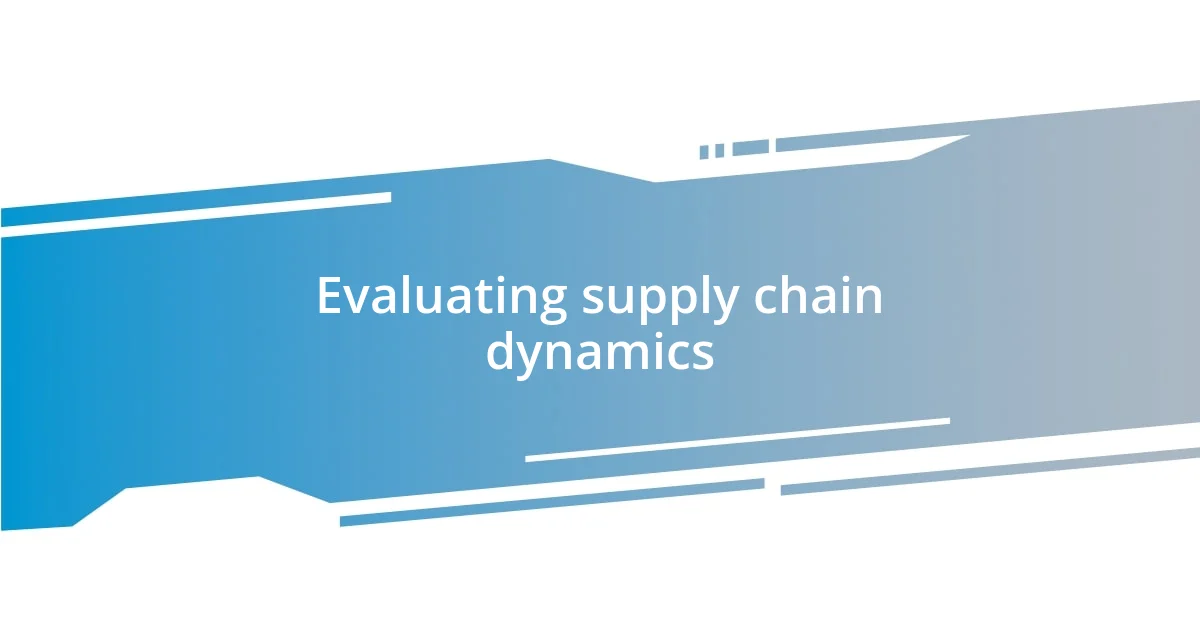Key takeaways:
- Graphite is essential for lithium-ion batteries, driving demand in electric vehicles and consumer electronics, marking a shift towards sustainable energy solutions.
- Regional dynamics are crucial, with Asia leading in production, North America showing growth in EV interest, and Europe emphasizing ethical sourcing regulations.
- Investment opportunities in graphite are expanding, focused on sustainable mining practices, and there is a growing importance of adaptability and ethical transparency in supply chains.

Understanding graphite market demand
When I first dove into the graphite market, I was struck by how its demand is intricately tied to innovation, especially in technology. As electric vehicles become more mainstream, I found myself contemplating: how essential is graphite in the battery production process? The truth is, graphite plays a pivotal role in the anode of lithium-ion batteries, making it a hot commodity as the world shifts toward sustainable energy solutions.
I recall visiting a manufacturing plant that specialized in producing batteries for these vehicles. The engineers shared how the demand for high-quality, natural graphite skyrocketed as they scaled production. Witnessing their enthusiasm was eye-opening; it painted a vivid picture of how a single material could drive an entire industry forward. This surge, I believe, is not just about numbers—it’s about a collective push toward a greener future.
Moreover, I’ve learned that consumer electronics are another significant contributor to graphite demand. Remember the last time you upgraded your smartphone? The tiny marvels we carry in our pockets rely heavily on graphite for their batteries. This revelation had me questioning: what other everyday items do we take for granted that could be influenced by shifts in graphite supply? As our lives become more dependent on technology, the implications for graphite demand become increasingly profound and intertwined with our daily experiences.

Researching key geographical markets
When I began pinpointing key geographical markets for graphite, I realized the significance of understanding regional variations and the unique demands each area presents. For instance, Asia—especially China—stands as a powerhouse in graphite production. I often pondered, why is this? Well, China’s investment in advanced technologies and infrastructure has positioned it as a significant player, making it crucial to monitor their market dynamics closely.
In my experience, North America is on the rise, especially with the increasing interest in electric vehicle production and high-tech battery advancements. I recently attended a conference that highlighted various North American companies ramping up their exploration and extraction projects. It was thrilling to witness the passion from industry leaders who are eager to make the shift toward sustainable sourcing. They shared stories that underscored how vital it is to stay ahead of regional trends, which can impact global pricing and availability tremendously.
It’s vital to also consider Europe, where regulatory frameworks favor sustainable mining practices, catching my attention as a growing market for ethically sourced graphite. I remember discussing with a colleague about the potential for European companies to innovate within the sustainability domain, and it sparked a new awareness of how such regulations can shape market trajectories. This emphasis on responsible sourcing is something I’ve found compelling; it not only drives demand but also inspires a culture of accountability in the industry.
| Region | Key Characteristics |
|---|---|
| Asia | Dominates production; heavy investments in tech |
| North America | Rising interest in EVs; focus on sustainable sourcing |
| Europe | Strong regulations favoring ethical practices |

Analyzing industry trends and forecasts
Understanding industry trends and forecasts in the graphite market has been an enlightening experience for me. I’ve noticed that the shift towards renewable energy technologies, particularly electric vehicles, isn’t just a trend; it’s a seismic shift in how we perceive energy consumption. At a recent workshop on sustainability, I felt the energy in the room as experts discussed projections for graphite demand over the next decade. Their confident predictions about market growth, driven by battery innovations, really made me see how critical it is to identify which companies and technologies stand to benefit most.
When I dug deeper, I came across several compelling trends:
– Sustainable sourcing is gaining momentum, influenced by consumer preferences for ethically produced materials.
– Technological advancements are accelerating graphite applications beyond batteries, such as in fuel cells and ultra-capacitors.
– Market volatility is evident, reflecting geopolitical tensions and environmental regulations that impact supply chains.
– Investment in R&D is skyrocketing as companies race to find high-performance graphite alternatives.
I still remember the conversation I had with a seasoned market analyst who emphasized the importance of staying ahead of these trends. He shared a startling statistic about projected electric vehicle sales doubling in the next few years, which made me appreciate how closely I need to monitor these forecasts. Taking a step back, I realized that these trends aren’t just numbers on a chart—they reflect a transformative time in our industry that calls for vigilance and adaptability.

Identifying major players in graphite
Identifying major players in the graphite market is crucial for understanding its dynamics. During my research, I found myself frequently turning to well-established companies like GrafTech International and Syrah Resources. These firms not only dominate production but also invest significantly in technology and sustainable practices. I often think, how do they maintain their competitive edge? They seem to make informed decisions based on extensive market analysis and strategic partnerships, crucial for staying relevant in such a fast-evolving landscape.
While digging deeper, I became aware of emerging players that pique my interest, such as Northern Graphite and NextSource Materials. Their novel approaches, especially in serving niche markets, opened my eyes to the potential disruption they can bring to established norms. I remember attending a panel where one of their CEOs passionately outlined plans for eco-friendly extraction methods. It made me ponder how innovation doesn’t just come from giants; sometimes, it’s the underdogs who can shift perceptions and spur change.
I can’t help but note the importance of alliances and joint ventures in this space. For instance, I recently read about a partnership between a North American graphite producer and a tech company aimed at developing sustainable battery solutions. That’s a great example of how collaboration can yield benefits that extend beyond just one company. Isn’t it fascinating how the right partnerships can redefine competition? In my experience, the interconnectivity among players in the market often means the difference between stagnation and groundbreaking progress.

Evaluating supply chain dynamics
Supply chain dynamics in the graphite market reveal intricate relationships that can make or break a business. While researching, I stumbled upon a case study detailing how logistical inefficiencies led to a significant delay for a company I’d never heard of before. This made me realize that understanding transportation and storage issues is just as vital as recognizing raw material sources. Have you ever considered how much distance travels can affect the cost and availability of materials? It’s astonishing how a simple hiccup in one region can ripple through the entire supply chain.
Another critical aspect I’ve observed is the role of regional geopolitics. I remember a panel discussion where experts highlighted how political instability in graphite-producing countries can create uncertainties for investors and manufacturers alike. This insight sparked a thought: what if we prioritized diversified sourcing strategies? By building a more resilient supply chain with multiple suppliers, companies could potentially shield themselves from sudden disruptions and fluctuations in graphite availability. Isn’t it intriguing to think about the value of adaptability in a constantly changing landscape?
I’ve also come to appreciate the importance of transparency in the supply chain. A few months back, I attended a seminar where a representative from a leading graphite producer talked passionately about the push for greater traceability. Their commitment to ethically sourced graphite resonated with me deeply, as it highlights the shift towards ethical consumerism in our industry. It made me ponder, how can we, as stakeholders, influence the movement towards a more responsible supply chain? I believe that our choices can lead to a ripple effect, encouraging more companies to follow suit in prioritizing ethical practices.

Exploring investment opportunities in graphite
When I first ventured into the world of graphite investment opportunities, I was struck by the sheer potential of this market. I recall sitting in a coffee shop, poring over reports that highlighted graphite’s crucial role in the burgeoning electric vehicle sector. It got me thinking—how can we overlook a material that’s so pivotal to energy storage technology? I realized then that investors are not only looking for profits but also seeking to be part of an eco-friendly revolution.
As I dug deeper, I started to see the opportunities sprouting in sustainable graphite mining. There was a moment during an industry event when I heard a presentation about a startup focused on 100% renewable energy sourcing for their graphite production. That was a lightbulb moment for me. It made me question, what if we prioritized businesses that integrate sustainability into their core values? Investing in such companies seemed not just logical but also aligned with a vision for a better future.
While evaluating investment paths, I’ve found that geographical factors play a significant role. One evening, driving through a region with rich mineral deposits, I felt an urge to explore up-and-coming locations for graphite mining. The local communities often have untapped potential, and I wondered how involvement in these areas could stimulate economic growth. Isn’t it compelling to think that investing in graphite might not only yield financial returns but also uplift communities? This perspective encourages me to look beyond mere numbers and analyze the broader impact of our investment decisions.














